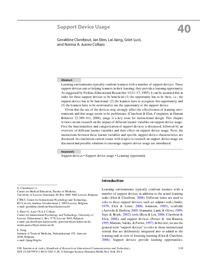Support Device UsageGeraldine Clarebout, Jan Elen, Lai Jiang, Griet Lust, Norma A. Juarez Collazo
Zu finden in: Handbook of Research on Educational Communications and Technology (Seite 519 bis 526), 2014
|
 |
 Diese Seite wurde seit 2 Jahren inhaltlich nicht mehr aktualisiert.
Unter Umständen ist sie nicht mehr aktuell.
Diese Seite wurde seit 2 Jahren inhaltlich nicht mehr aktualisiert.
Unter Umständen ist sie nicht mehr aktuell.
 Zusammenfassungen
Zusammenfassungen
 Learning environments typically confront learners with a number of support devices. These support devices aim at helping learners in their learning; they provide a learning opportunity. As suggested by Perkins (Educational Researcher 14:11-17, 1985), it can be assumed that in order for these support devices to be beneficial (1) the opportunity has to be there, i.e., the support device has to be functional; (2) the learners have to recognize this opportunity, and (3) the learners have to be motivated to use the opportunity or the support device.
Learning environments typically confront learners with a number of support devices. These support devices aim at helping learners in their learning; they provide a learning opportunity. As suggested by Perkins (Educational Researcher 14:11-17, 1985), it can be assumed that in order for these support devices to be beneficial (1) the opportunity has to be there, i.e., the support device has to be functional; (2) the learners have to recognize this opportunity, and (3) the learners have to be motivated to use the opportunity or the support device.Given that the use of the devices may strongly affect the effectiveness of learning environments and that usage seems to be problematic (Clarebout & Elen, Computers in Human Behavior 22:389-411, 2006), usage is a key issue for instructional design. This chapter reviews recent research on the impact of different learner variables on support device usage. First the functionalities and categorization of support devices is discussed, followed by an overview of different learner variables and their effect on support device usage. Next, the interactions between these learner variables and specific support device characteristics are discussed. In conclusion current issues with respect to research on support device usage are discussed and possible solutions to encourage support device usage are introduced.
 Dieses Kapitel erwähnt ...
Dieses Kapitel erwähnt ...
 Personen KB IB clear | David H. Jonassen , Ard W. Lazonder , Lew Semjonowitsch Vygotsky | ||||||||||||||||||||||||||||||||||||
 Begriffe KB IB clear | cognitive load theory (CLT)
, Cognitive Toolscognitive tools
,  Lernen Lernen learning
, learning
,  Motivation Motivation motivation
, Zone of Proximal Development motivation
, Zone of Proximal Development
| ||||||||||||||||||||||||||||||||||||
 Bücher |
| ||||||||||||||||||||||||||||||||||||
 Texte |
|
 Zitationsgraph
Zitationsgraph
 Zitationsgraph (Beta-Test mit vis.js)
Zitationsgraph (Beta-Test mit vis.js)
 Anderswo finden
Anderswo finden
 Volltext dieses Dokuments
Volltext dieses Dokuments
 |  Support Device Usage: Artikel als Volltext bei Springerlink ( Support Device Usage: Artikel als Volltext bei Springerlink ( : :  , 237 kByte; , 237 kByte;  : :  2020-11-28) 2020-11-28) |
 Anderswo suchen
Anderswo suchen 
 Beat und dieses Kapitel
Beat und dieses Kapitel
Beat hat Dieses Kapitel während seiner Zeit am Institut für Medien und Schule (IMS) ins Biblionetz aufgenommen. Beat besitzt kein physisches, aber ein digitales Exemplar. Eine digitale Version ist auf dem Internet verfügbar (s.o.). Aufgrund der wenigen Einträge im Biblionetz scheint er es nicht wirklich gelesen zu haben. Es gibt bisher auch nur wenige Objekte im Biblionetz, die dieses Werk zitieren.











 Biblionetz-History
Biblionetz-History